SIM335 Managing Projects Report: University of Sunderland London
VerifiedAdded on 2023/01/11
|16
|3994
|95
Report
AI Summary
This report provides a comprehensive overview of project management principles and practices. It begins by defining key project characteristics and emphasizing the importance of integration management. The report then delves into the scope statement, detailing the role of the Work Breakd...

Managing Projects
Paraphrase This Document
Need a fresh take? Get an instant paraphrase of this document with our AI Paraphraser
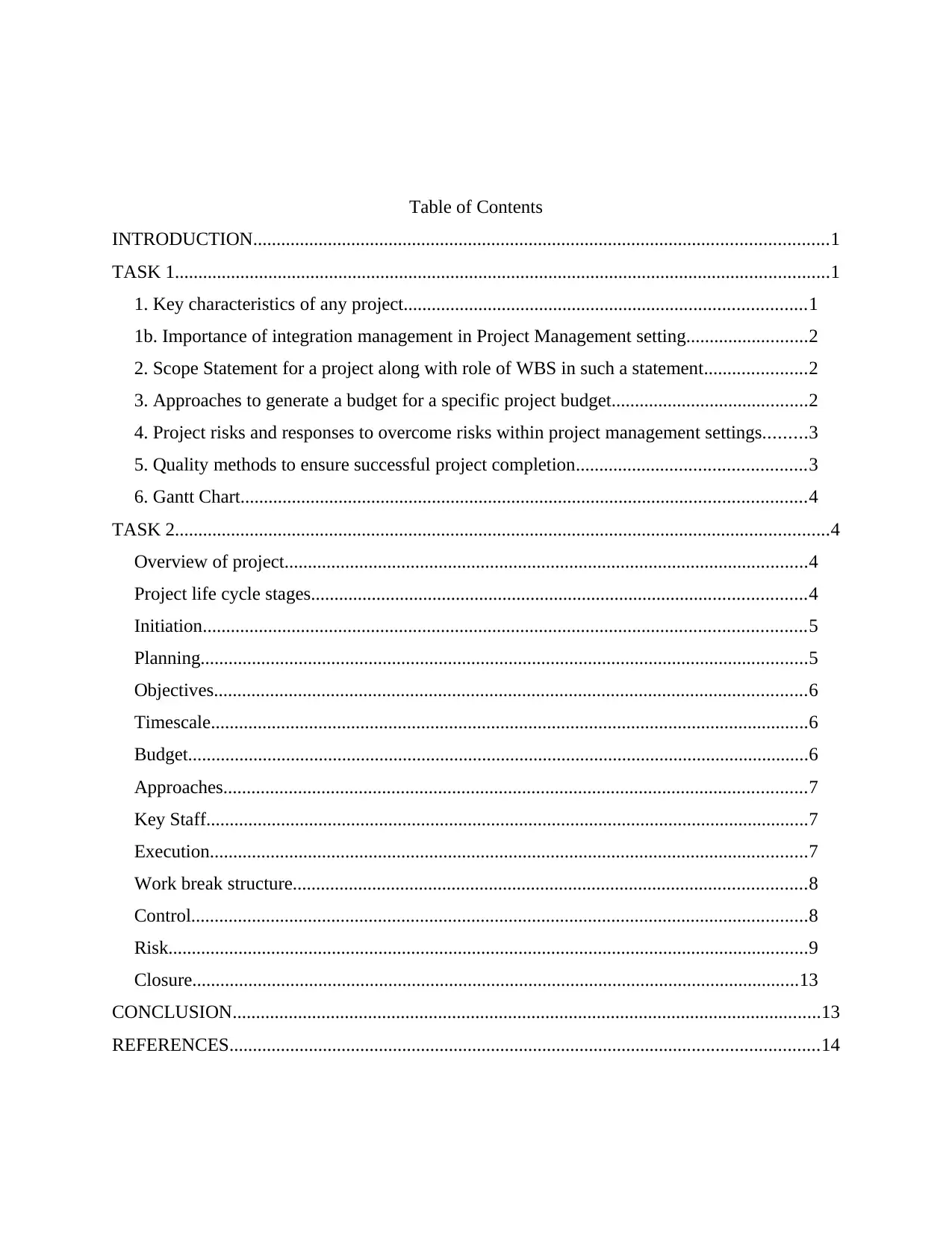
Table of Contents
INTRODUCTION...........................................................................................................................1
TASK 1............................................................................................................................................1
1. Key characteristics of any project......................................................................................1
1b. Importance of integration management in Project Management setting..........................2
2. Scope Statement for a project along with role of WBS in such a statement......................2
3. Approaches to generate a budget for a specific project budget..........................................2
4. Project risks and responses to overcome risks within project management settings.........3
5. Quality methods to ensure successful project completion.................................................3
6. Gantt Chart.........................................................................................................................4
TASK 2............................................................................................................................................4
Overview of project................................................................................................................4
Project life cycle stages..........................................................................................................4
Initiation.................................................................................................................................5
Planning..................................................................................................................................5
Objectives...............................................................................................................................6
Timescale................................................................................................................................6
Budget.....................................................................................................................................6
Approaches.............................................................................................................................7
Key Staff.................................................................................................................................7
Execution................................................................................................................................7
Work break structure..............................................................................................................8
Control....................................................................................................................................8
Risk.........................................................................................................................................9
Closure..................................................................................................................................13
CONCLUSION..............................................................................................................................13
REFERENCES..............................................................................................................................14
INTRODUCTION...........................................................................................................................1
TASK 1............................................................................................................................................1
1. Key characteristics of any project......................................................................................1
1b. Importance of integration management in Project Management setting..........................2
2. Scope Statement for a project along with role of WBS in such a statement......................2
3. Approaches to generate a budget for a specific project budget..........................................2
4. Project risks and responses to overcome risks within project management settings.........3
5. Quality methods to ensure successful project completion.................................................3
6. Gantt Chart.........................................................................................................................4
TASK 2............................................................................................................................................4
Overview of project................................................................................................................4
Project life cycle stages..........................................................................................................4
Initiation.................................................................................................................................5
Planning..................................................................................................................................5
Objectives...............................................................................................................................6
Timescale................................................................................................................................6
Budget.....................................................................................................................................6
Approaches.............................................................................................................................7
Key Staff.................................................................................................................................7
Execution................................................................................................................................7
Work break structure..............................................................................................................8
Control....................................................................................................................................8
Risk.........................................................................................................................................9
Closure..................................................................................................................................13
CONCLUSION..............................................................................................................................13
REFERENCES..............................................................................................................................14
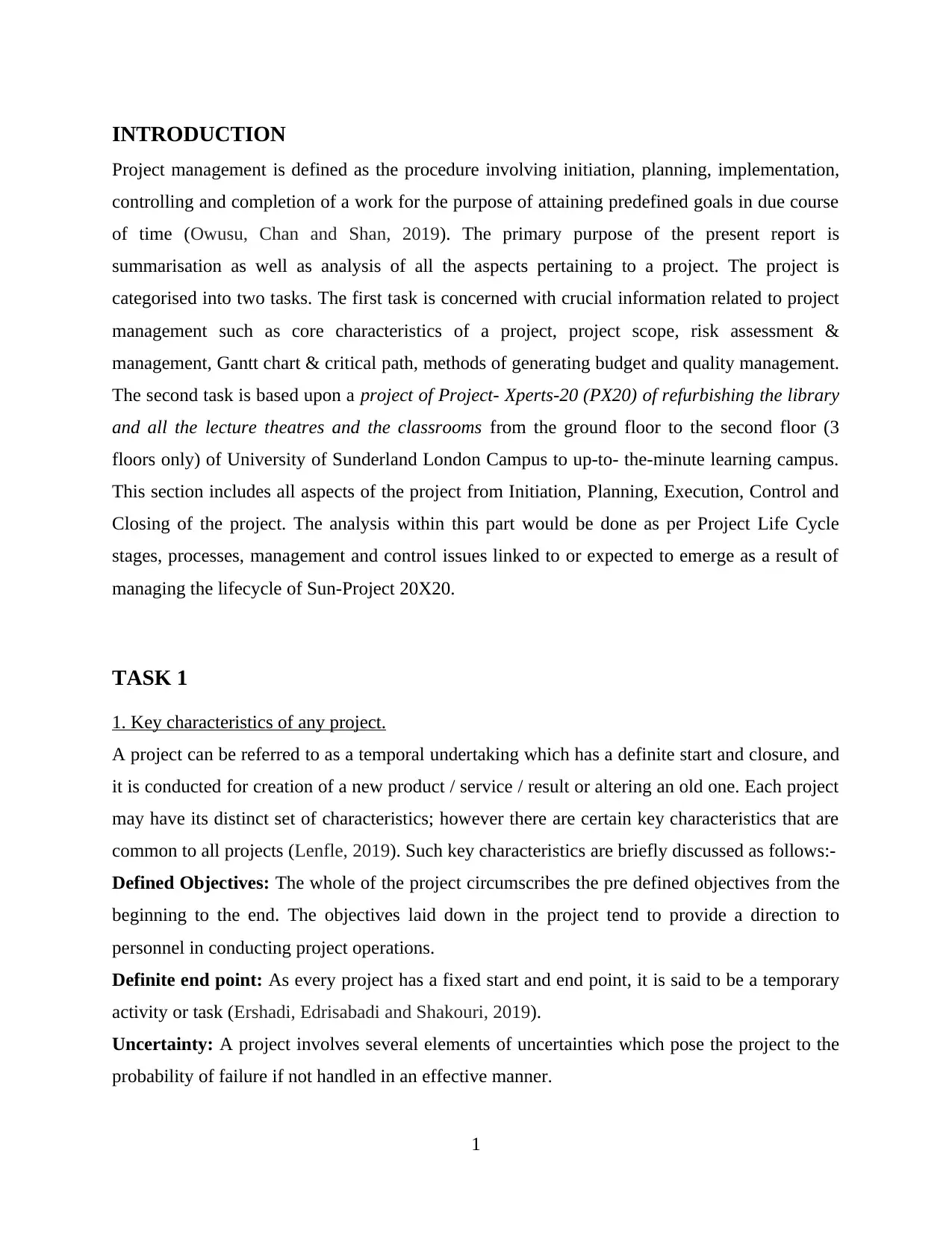
INTRODUCTION
Project management is defined as the procedure involving initiation, planning, implementation,
controlling and completion of a work for the purpose of attaining predefined goals in due course
of time (Owusu, Chan and Shan, 2019). The primary purpose of the present report is
summarisation as well as analysis of all the aspects pertaining to a project. The project is
categorised into two tasks. The first task is concerned with crucial information related to project
management such as core characteristics of a project, project scope, risk assessment &
management, Gantt chart & critical path, methods of generating budget and quality management.
The second task is based upon a project of Project- Xperts-20 (PX20) of refurbishing the library
and all the lecture theatres and the classrooms from the ground floor to the second floor (3
floors only) of University of Sunderland London Campus to up-to- the-minute learning campus.
This section includes all aspects of the project from Initiation, Planning, Execution, Control and
Closing of the project. The analysis within this part would be done as per Project Life Cycle
stages, processes, management and control issues linked to or expected to emerge as a result of
managing the lifecycle of Sun-Project 20X20.
TASK 1
1. Key characteristics of any project.
A project can be referred to as a temporal undertaking which has a definite start and closure, and
it is conducted for creation of a new product / service / result or altering an old one. Each project
may have its distinct set of characteristics; however there are certain key characteristics that are
common to all projects (Lenfle, 2019). Such key characteristics are briefly discussed as follows:-
Defined Objectives: The whole of the project circumscribes the pre defined objectives from the
beginning to the end. The objectives laid down in the project tend to provide a direction to
personnel in conducting project operations.
Definite end point: As every project has a fixed start and end point, it is said to be a temporary
activity or task (Ershadi, Edrisabadi and Shakouri, 2019).
Uncertainty: A project involves several elements of uncertainties which pose the project to the
probability of failure if not handled in an effective manner.
1
Project management is defined as the procedure involving initiation, planning, implementation,
controlling and completion of a work for the purpose of attaining predefined goals in due course
of time (Owusu, Chan and Shan, 2019). The primary purpose of the present report is
summarisation as well as analysis of all the aspects pertaining to a project. The project is
categorised into two tasks. The first task is concerned with crucial information related to project
management such as core characteristics of a project, project scope, risk assessment &
management, Gantt chart & critical path, methods of generating budget and quality management.
The second task is based upon a project of Project- Xperts-20 (PX20) of refurbishing the library
and all the lecture theatres and the classrooms from the ground floor to the second floor (3
floors only) of University of Sunderland London Campus to up-to- the-minute learning campus.
This section includes all aspects of the project from Initiation, Planning, Execution, Control and
Closing of the project. The analysis within this part would be done as per Project Life Cycle
stages, processes, management and control issues linked to or expected to emerge as a result of
managing the lifecycle of Sun-Project 20X20.
TASK 1
1. Key characteristics of any project.
A project can be referred to as a temporal undertaking which has a definite start and closure, and
it is conducted for creation of a new product / service / result or altering an old one. Each project
may have its distinct set of characteristics; however there are certain key characteristics that are
common to all projects (Lenfle, 2019). Such key characteristics are briefly discussed as follows:-
Defined Objectives: The whole of the project circumscribes the pre defined objectives from the
beginning to the end. The objectives laid down in the project tend to provide a direction to
personnel in conducting project operations.
Definite end point: As every project has a fixed start and end point, it is said to be a temporary
activity or task (Ershadi, Edrisabadi and Shakouri, 2019).
Uncertainty: A project involves several elements of uncertainties which pose the project to the
probability of failure if not handled in an effective manner.
1
⊘ This is a preview!⊘
Do you want full access?
Subscribe today to unlock all pages.

Trusted by 1+ million students worldwide
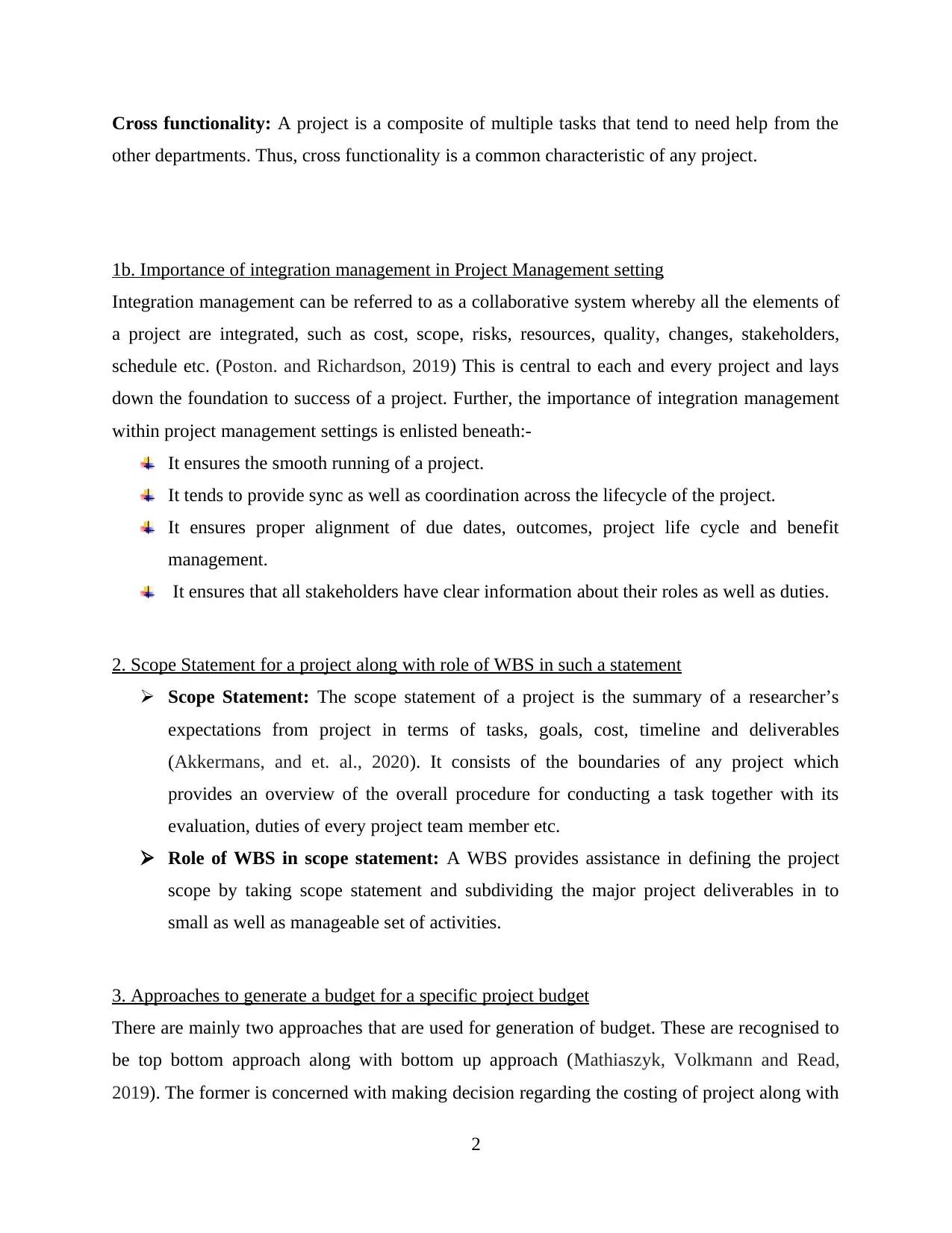
Cross functionality: A project is a composite of multiple tasks that tend to need help from the
other departments. Thus, cross functionality is a common characteristic of any project.
1b. Importance of integration management in Project Management setting
Integration management can be referred to as a collaborative system whereby all the elements of
a project are integrated, such as cost, scope, risks, resources, quality, changes, stakeholders,
schedule etc. (Poston. and Richardson, 2019) This is central to each and every project and lays
down the foundation to success of a project. Further, the importance of integration management
within project management settings is enlisted beneath:-
It ensures the smooth running of a project.
It tends to provide sync as well as coordination across the lifecycle of the project.
It ensures proper alignment of due dates, outcomes, project life cycle and benefit
management.
It ensures that all stakeholders have clear information about their roles as well as duties.
2. Scope Statement for a project along with role of WBS in such a statement
Scope Statement: The scope statement of a project is the summary of a researcher’s
expectations from project in terms of tasks, goals, cost, timeline and deliverables
(Akkermans, and et. al., 2020). It consists of the boundaries of any project which
provides an overview of the overall procedure for conducting a task together with its
evaluation, duties of every project team member etc.
Role of WBS in scope statement: A WBS provides assistance in defining the project
scope by taking scope statement and subdividing the major project deliverables in to
small as well as manageable set of activities.
3. Approaches to generate a budget for a specific project budget
There are mainly two approaches that are used for generation of budget. These are recognised to
be top bottom approach along with bottom up approach (Mathiaszyk, Volkmann and Read,
2019). The former is concerned with making decision regarding the costing of project along with
2
other departments. Thus, cross functionality is a common characteristic of any project.
1b. Importance of integration management in Project Management setting
Integration management can be referred to as a collaborative system whereby all the elements of
a project are integrated, such as cost, scope, risks, resources, quality, changes, stakeholders,
schedule etc. (Poston. and Richardson, 2019) This is central to each and every project and lays
down the foundation to success of a project. Further, the importance of integration management
within project management settings is enlisted beneath:-
It ensures the smooth running of a project.
It tends to provide sync as well as coordination across the lifecycle of the project.
It ensures proper alignment of due dates, outcomes, project life cycle and benefit
management.
It ensures that all stakeholders have clear information about their roles as well as duties.
2. Scope Statement for a project along with role of WBS in such a statement
Scope Statement: The scope statement of a project is the summary of a researcher’s
expectations from project in terms of tasks, goals, cost, timeline and deliverables
(Akkermans, and et. al., 2020). It consists of the boundaries of any project which
provides an overview of the overall procedure for conducting a task together with its
evaluation, duties of every project team member etc.
Role of WBS in scope statement: A WBS provides assistance in defining the project
scope by taking scope statement and subdividing the major project deliverables in to
small as well as manageable set of activities.
3. Approaches to generate a budget for a specific project budget
There are mainly two approaches that are used for generation of budget. These are recognised to
be top bottom approach along with bottom up approach (Mathiaszyk, Volkmann and Read,
2019). The former is concerned with making decision regarding the costing of project along with
2
Paraphrase This Document
Need a fresh take? Get an instant paraphrase of this document with our AI Paraphraser
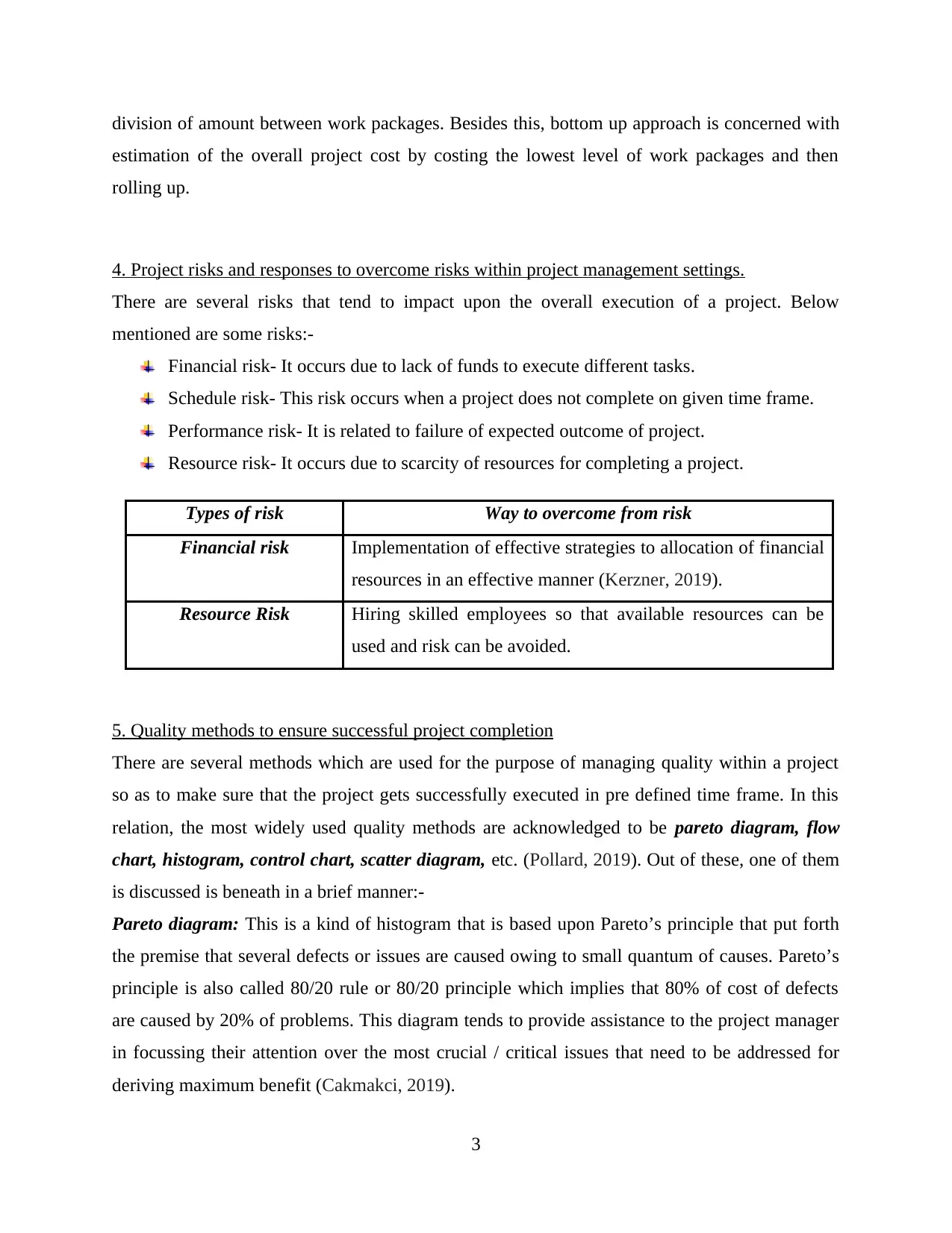
division of amount between work packages. Besides this, bottom up approach is concerned with
estimation of the overall project cost by costing the lowest level of work packages and then
rolling up.
4. Project risks and responses to overcome risks within project management settings.
There are several risks that tend to impact upon the overall execution of a project. Below
mentioned are some risks:-
Financial risk- It occurs due to lack of funds to execute different tasks.
Schedule risk- This risk occurs when a project does not complete on given time frame.
Performance risk- It is related to failure of expected outcome of project.
Resource risk- It occurs due to scarcity of resources for completing a project.
Types of risk Way to overcome from risk
Financial risk Implementation of effective strategies to allocation of financial
resources in an effective manner (Kerzner, 2019).
Resource Risk Hiring skilled employees so that available resources can be
used and risk can be avoided.
5. Quality methods to ensure successful project completion
There are several methods which are used for the purpose of managing quality within a project
so as to make sure that the project gets successfully executed in pre defined time frame. In this
relation, the most widely used quality methods are acknowledged to be pareto diagram, flow
chart, histogram, control chart, scatter diagram, etc. (Pollard, 2019). Out of these, one of them
is discussed is beneath in a brief manner:-
Pareto diagram: This is a kind of histogram that is based upon Pareto’s principle that put forth
the premise that several defects or issues are caused owing to small quantum of causes. Pareto’s
principle is also called 80/20 rule or 80/20 principle which implies that 80% of cost of defects
are caused by 20% of problems. This diagram tends to provide assistance to the project manager
in focussing their attention over the most crucial / critical issues that need to be addressed for
deriving maximum benefit (Cakmakci, 2019).
3
estimation of the overall project cost by costing the lowest level of work packages and then
rolling up.
4. Project risks and responses to overcome risks within project management settings.
There are several risks that tend to impact upon the overall execution of a project. Below
mentioned are some risks:-
Financial risk- It occurs due to lack of funds to execute different tasks.
Schedule risk- This risk occurs when a project does not complete on given time frame.
Performance risk- It is related to failure of expected outcome of project.
Resource risk- It occurs due to scarcity of resources for completing a project.
Types of risk Way to overcome from risk
Financial risk Implementation of effective strategies to allocation of financial
resources in an effective manner (Kerzner, 2019).
Resource Risk Hiring skilled employees so that available resources can be
used and risk can be avoided.
5. Quality methods to ensure successful project completion
There are several methods which are used for the purpose of managing quality within a project
so as to make sure that the project gets successfully executed in pre defined time frame. In this
relation, the most widely used quality methods are acknowledged to be pareto diagram, flow
chart, histogram, control chart, scatter diagram, etc. (Pollard, 2019). Out of these, one of them
is discussed is beneath in a brief manner:-
Pareto diagram: This is a kind of histogram that is based upon Pareto’s principle that put forth
the premise that several defects or issues are caused owing to small quantum of causes. Pareto’s
principle is also called 80/20 rule or 80/20 principle which implies that 80% of cost of defects
are caused by 20% of problems. This diagram tends to provide assistance to the project manager
in focussing their attention over the most crucial / critical issues that need to be addressed for
deriving maximum benefit (Cakmakci, 2019).
3
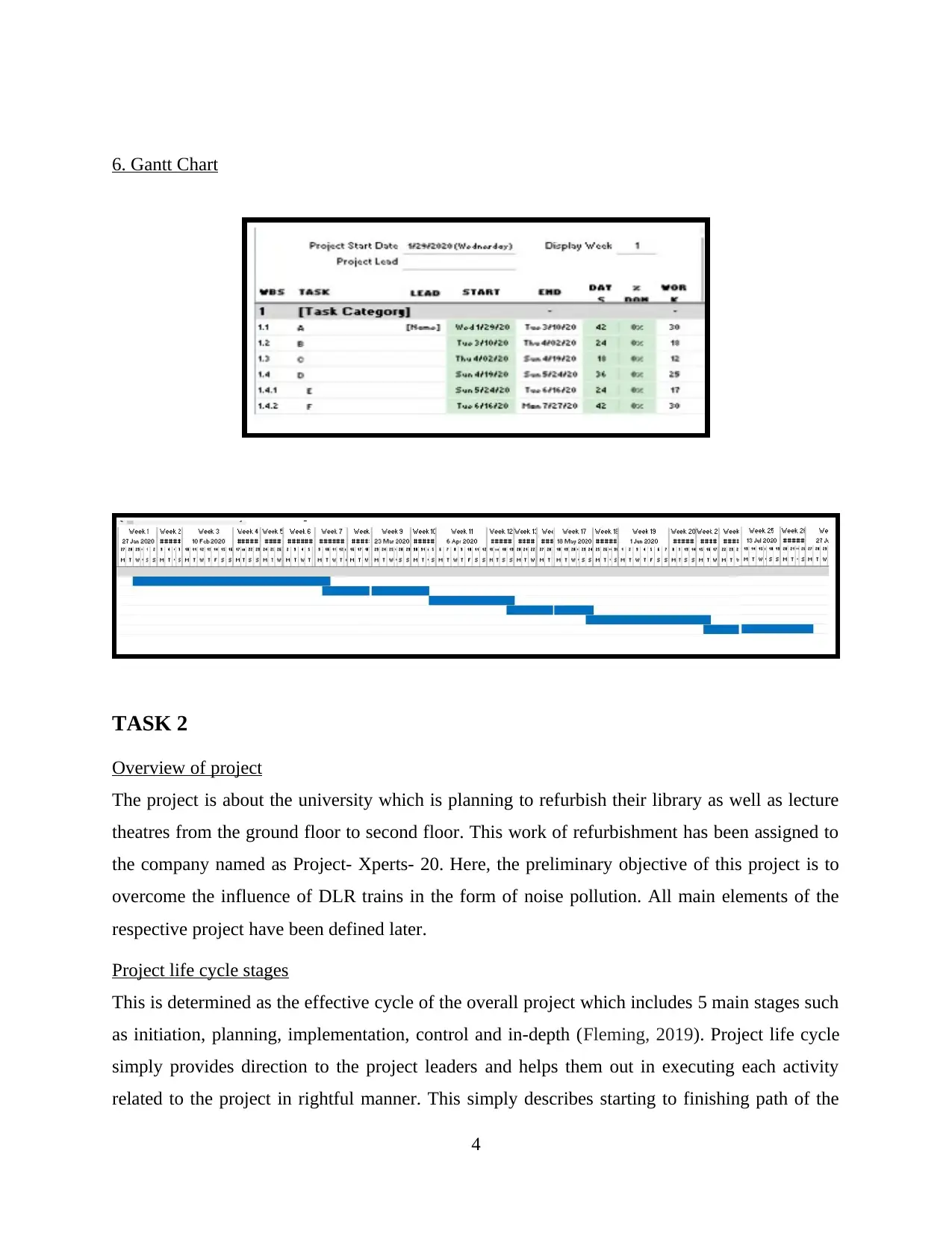
6. Gantt Chart
TASK 2
Overview of project
The project is about the university which is planning to refurbish their library as well as lecture
theatres from the ground floor to second floor. This work of refurbishment has been assigned to
the company named as Project- Xperts- 20. Here, the preliminary objective of this project is to
overcome the influence of DLR trains in the form of noise pollution. All main elements of the
respective project have been defined later.
Project life cycle stages
This is determined as the effective cycle of the overall project which includes 5 main stages such
as initiation, planning, implementation, control and in-depth (Fleming, 2019). Project life cycle
simply provides direction to the project leaders and helps them out in executing each activity
related to the project in rightful manner. This simply describes starting to finishing path of the
4
TASK 2
Overview of project
The project is about the university which is planning to refurbish their library as well as lecture
theatres from the ground floor to second floor. This work of refurbishment has been assigned to
the company named as Project- Xperts- 20. Here, the preliminary objective of this project is to
overcome the influence of DLR trains in the form of noise pollution. All main elements of the
respective project have been defined later.
Project life cycle stages
This is determined as the effective cycle of the overall project which includes 5 main stages such
as initiation, planning, implementation, control and in-depth (Fleming, 2019). Project life cycle
simply provides direction to the project leaders and helps them out in executing each activity
related to the project in rightful manner. This simply describes starting to finishing path of the
4
⊘ This is a preview!⊘
Do you want full access?
Subscribe today to unlock all pages.

Trusted by 1+ million students worldwide
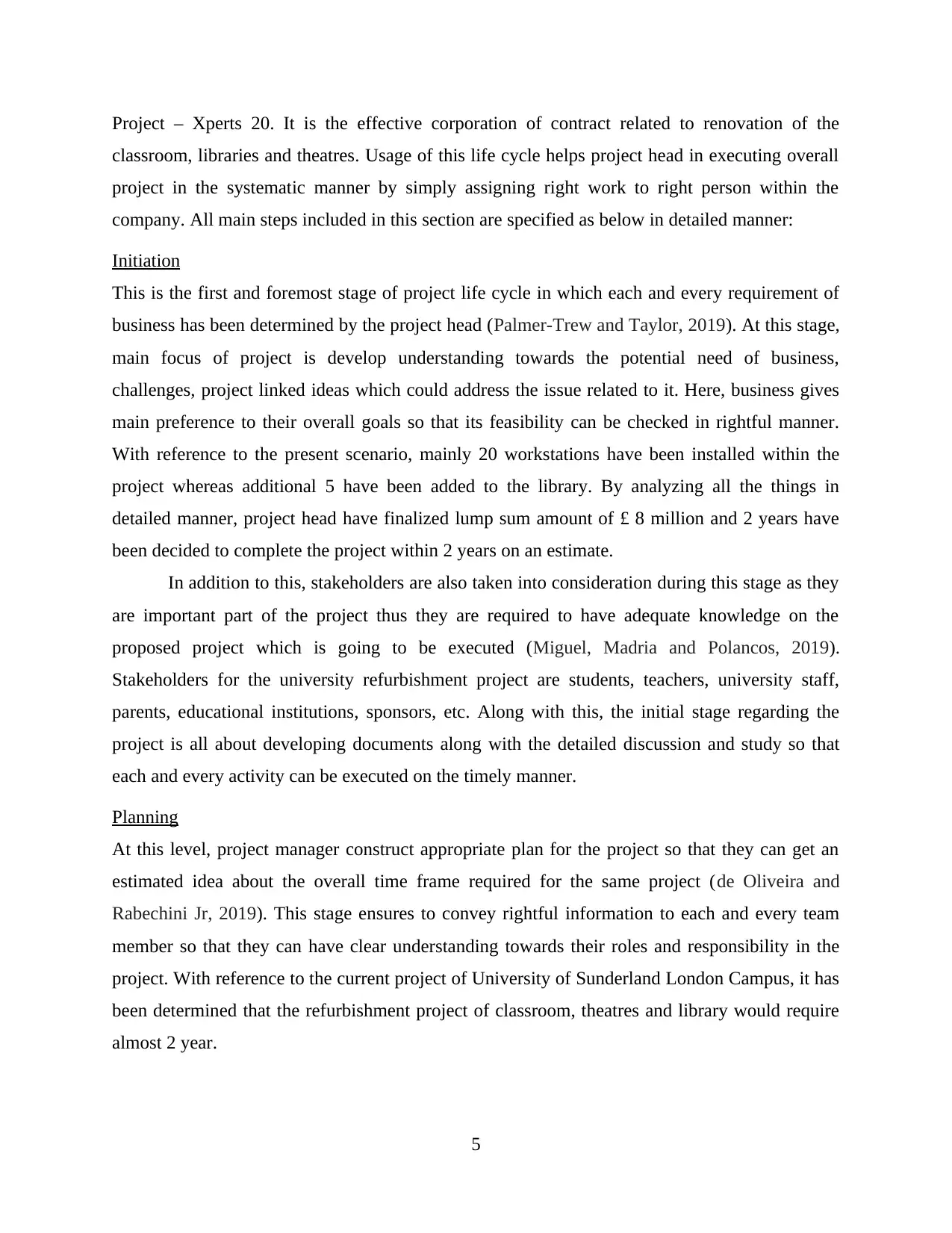
Project – Xperts 20. It is the effective corporation of contract related to renovation of the
classroom, libraries and theatres. Usage of this life cycle helps project head in executing overall
project in the systematic manner by simply assigning right work to right person within the
company. All main steps included in this section are specified as below in detailed manner:
Initiation
This is the first and foremost stage of project life cycle in which each and every requirement of
business has been determined by the project head (Palmer-Trew and Taylor, 2019). At this stage,
main focus of project is develop understanding towards the potential need of business,
challenges, project linked ideas which could address the issue related to it. Here, business gives
main preference to their overall goals so that its feasibility can be checked in rightful manner.
With reference to the present scenario, mainly 20 workstations have been installed within the
project whereas additional 5 have been added to the library. By analyzing all the things in
detailed manner, project head have finalized lump sum amount of £ 8 million and 2 years have
been decided to complete the project within 2 years on an estimate.
In addition to this, stakeholders are also taken into consideration during this stage as they
are important part of the project thus they are required to have adequate knowledge on the
proposed project which is going to be executed (Miguel, Madria and Polancos, 2019).
Stakeholders for the university refurbishment project are students, teachers, university staff,
parents, educational institutions, sponsors, etc. Along with this, the initial stage regarding the
project is all about developing documents along with the detailed discussion and study so that
each and every activity can be executed on the timely manner.
Planning
At this level, project manager construct appropriate plan for the project so that they can get an
estimated idea about the overall time frame required for the same project (de Oliveira and
Rabechini Jr, 2019). This stage ensures to convey rightful information to each and every team
member so that they can have clear understanding towards their roles and responsibility in the
project. With reference to the current project of University of Sunderland London Campus, it has
been determined that the refurbishment project of classroom, theatres and library would require
almost 2 year.
5
classroom, libraries and theatres. Usage of this life cycle helps project head in executing overall
project in the systematic manner by simply assigning right work to right person within the
company. All main steps included in this section are specified as below in detailed manner:
Initiation
This is the first and foremost stage of project life cycle in which each and every requirement of
business has been determined by the project head (Palmer-Trew and Taylor, 2019). At this stage,
main focus of project is develop understanding towards the potential need of business,
challenges, project linked ideas which could address the issue related to it. Here, business gives
main preference to their overall goals so that its feasibility can be checked in rightful manner.
With reference to the present scenario, mainly 20 workstations have been installed within the
project whereas additional 5 have been added to the library. By analyzing all the things in
detailed manner, project head have finalized lump sum amount of £ 8 million and 2 years have
been decided to complete the project within 2 years on an estimate.
In addition to this, stakeholders are also taken into consideration during this stage as they
are important part of the project thus they are required to have adequate knowledge on the
proposed project which is going to be executed (Miguel, Madria and Polancos, 2019).
Stakeholders for the university refurbishment project are students, teachers, university staff,
parents, educational institutions, sponsors, etc. Along with this, the initial stage regarding the
project is all about developing documents along with the detailed discussion and study so that
each and every activity can be executed on the timely manner.
Planning
At this level, project manager construct appropriate plan for the project so that they can get an
estimated idea about the overall time frame required for the same project (de Oliveira and
Rabechini Jr, 2019). This stage ensures to convey rightful information to each and every team
member so that they can have clear understanding towards their roles and responsibility in the
project. With reference to the current project of University of Sunderland London Campus, it has
been determined that the refurbishment project of classroom, theatres and library would require
almost 2 year.
5
Paraphrase This Document
Need a fresh take? Get an instant paraphrase of this document with our AI Paraphraser
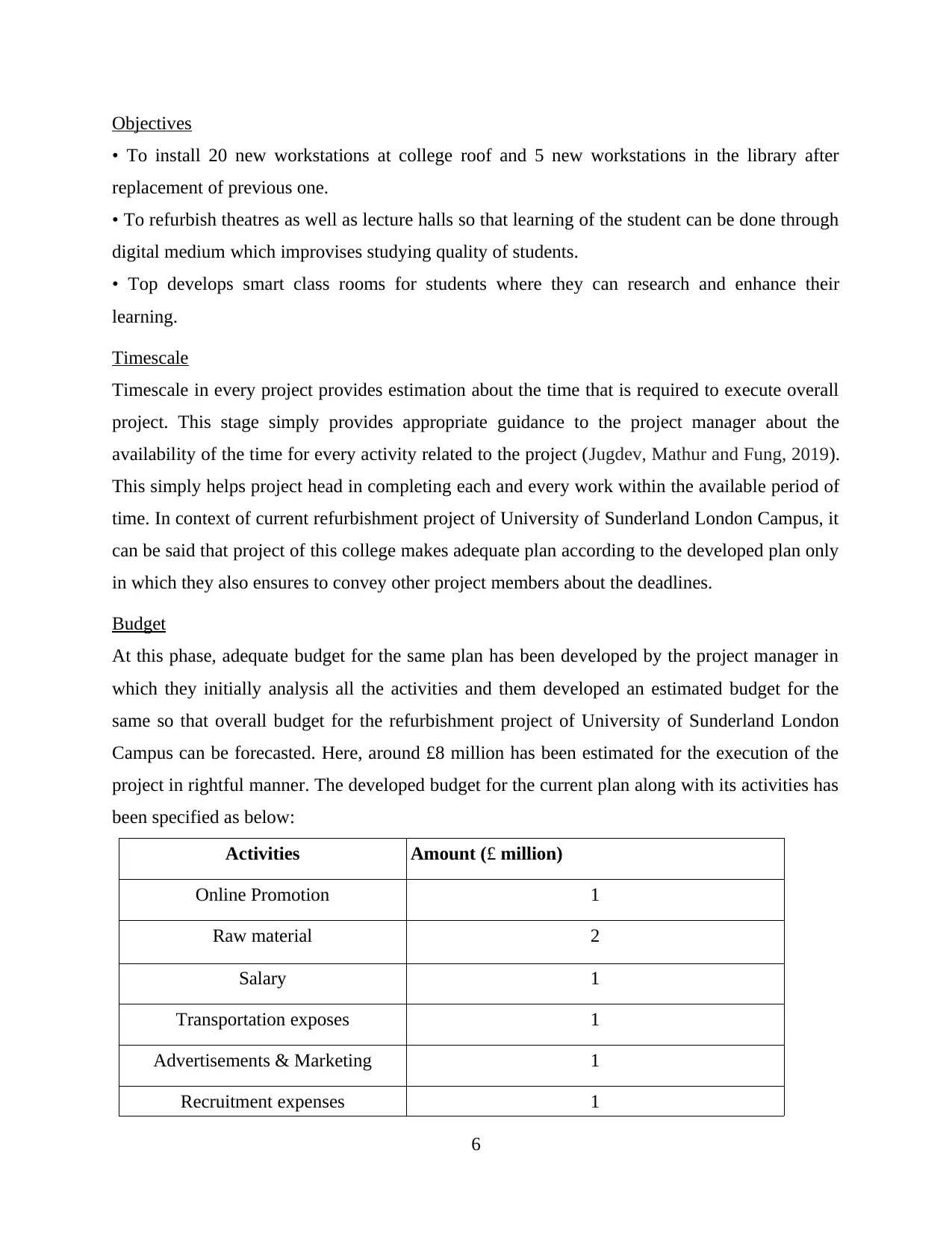
Objectives
• To install 20 new workstations at college roof and 5 new workstations in the library after
replacement of previous one.
• To refurbish theatres as well as lecture halls so that learning of the student can be done through
digital medium which improvises studying quality of students.
• Top develops smart class rooms for students where they can research and enhance their
learning.
Timescale
Timescale in every project provides estimation about the time that is required to execute overall
project. This stage simply provides appropriate guidance to the project manager about the
availability of the time for every activity related to the project (Jugdev, Mathur and Fung, 2019).
This simply helps project head in completing each and every work within the available period of
time. In context of current refurbishment project of University of Sunderland London Campus, it
can be said that project of this college makes adequate plan according to the developed plan only
in which they also ensures to convey other project members about the deadlines.
Budget
At this phase, adequate budget for the same plan has been developed by the project manager in
which they initially analysis all the activities and them developed an estimated budget for the
same so that overall budget for the refurbishment project of University of Sunderland London
Campus can be forecasted. Here, around £8 million has been estimated for the execution of the
project in rightful manner. The developed budget for the current plan along with its activities has
been specified as below:
Activities Amount (£ million)
Online Promotion 1
Raw material 2
Salary 1
Transportation exposes 1
Advertisements & Marketing 1
Recruitment expenses 1
6
• To install 20 new workstations at college roof and 5 new workstations in the library after
replacement of previous one.
• To refurbish theatres as well as lecture halls so that learning of the student can be done through
digital medium which improvises studying quality of students.
• Top develops smart class rooms for students where they can research and enhance their
learning.
Timescale
Timescale in every project provides estimation about the time that is required to execute overall
project. This stage simply provides appropriate guidance to the project manager about the
availability of the time for every activity related to the project (Jugdev, Mathur and Fung, 2019).
This simply helps project head in completing each and every work within the available period of
time. In context of current refurbishment project of University of Sunderland London Campus, it
can be said that project of this college makes adequate plan according to the developed plan only
in which they also ensures to convey other project members about the deadlines.
Budget
At this phase, adequate budget for the same plan has been developed by the project manager in
which they initially analysis all the activities and them developed an estimated budget for the
same so that overall budget for the refurbishment project of University of Sunderland London
Campus can be forecasted. Here, around £8 million has been estimated for the execution of the
project in rightful manner. The developed budget for the current plan along with its activities has
been specified as below:
Activities Amount (£ million)
Online Promotion 1
Raw material 2
Salary 1
Transportation exposes 1
Advertisements & Marketing 1
Recruitment expenses 1
6

Training expenses 1
Total 8
Approaches
At this stage main focus of the project head is on developing adequate strategy which will be
adopted by the project head as well as associated members (Jugdev, Mathur and Fung, 2019).
This simply provides direction to all linked people also helps them out obtaining predetermined
project goals and objectives.
Key Staff
The Sunderland London campus team leaders have decided to recruit staff which helps them to
achieve their goal in particular time by simply performing the assigned work. In order to run
their project in smooth manner they need to hire some professional and provide them training to
enhance their skills. While recruiting the candidates, the project manager defines some of the
qualities such as leadership skill, imaginative, organization skill, emotional, insightful etc that
should be possessed by applicants in order to acquire the particular position in the project of
refurbishment. Here, the main role of project head is to satisfy the requirement of the position in
the company. The manager of the team decides the roles which have to be fulfilled by the staff of
the company to accomplish their mission.
Execution
The project execution is the longest phase in every life cycle of project. In this process,
the project takes approval by the higher authority of University before executing the work related
to refurbishment (Jugdev, Mathur and Fung, 2019). This stage simply includes range of project
activities which are executed by project manager by handling their team properly as they can
manage their work properly. The team members are directly guided by the project manager so
that they can achieve their specific goal and objectives before deadline. Interaction between
project leader as well as team members also helps in increasing performance of staff and also
solves their issues which can delay the execution. The team head emphasis on taking regular
feedback from project member so that they can implement on required modification.
7
Total 8
Approaches
At this stage main focus of the project head is on developing adequate strategy which will be
adopted by the project head as well as associated members (Jugdev, Mathur and Fung, 2019).
This simply provides direction to all linked people also helps them out obtaining predetermined
project goals and objectives.
Key Staff
The Sunderland London campus team leaders have decided to recruit staff which helps them to
achieve their goal in particular time by simply performing the assigned work. In order to run
their project in smooth manner they need to hire some professional and provide them training to
enhance their skills. While recruiting the candidates, the project manager defines some of the
qualities such as leadership skill, imaginative, organization skill, emotional, insightful etc that
should be possessed by applicants in order to acquire the particular position in the project of
refurbishment. Here, the main role of project head is to satisfy the requirement of the position in
the company. The manager of the team decides the roles which have to be fulfilled by the staff of
the company to accomplish their mission.
Execution
The project execution is the longest phase in every life cycle of project. In this process,
the project takes approval by the higher authority of University before executing the work related
to refurbishment (Jugdev, Mathur and Fung, 2019). This stage simply includes range of project
activities which are executed by project manager by handling their team properly as they can
manage their work properly. The team members are directly guided by the project manager so
that they can achieve their specific goal and objectives before deadline. Interaction between
project leader as well as team members also helps in increasing performance of staff and also
solves their issues which can delay the execution. The team head emphasis on taking regular
feedback from project member so that they can implement on required modification.
7
⊘ This is a preview!⊘
Do you want full access?
Subscribe today to unlock all pages.

Trusted by 1+ million students worldwide

Work break structure
This structure is basically developed by the project manager in order to the break the overall
project into smaller section thus it could be implemented within the limited period of time.
Development of work break down helps project manager in completing overall project in the
systematic manner. In context of the current project of University of Sunderland London
Campus, its project head has developed work break down structure as per the project life cycle
that has been specified as below:-
Control
At this level, project manager emphasizes on going through the overall project cycle so that they
can easily develop their understanding over the lack areas or the place where their modifications
are mandatorily required (Mathiaszyk, Volkmann and Read, 2019). In order to so in effective
manner each and every activity of project members is tracked at constant basis so that they
control those activities which are not adding value to the project in the rightful manner. This
8
This structure is basically developed by the project manager in order to the break the overall
project into smaller section thus it could be implemented within the limited period of time.
Development of work break down helps project manager in completing overall project in the
systematic manner. In context of the current project of University of Sunderland London
Campus, its project head has developed work break down structure as per the project life cycle
that has been specified as below:-
Control
At this level, project manager emphasizes on going through the overall project cycle so that they
can easily develop their understanding over the lack areas or the place where their modifications
are mandatorily required (Mathiaszyk, Volkmann and Read, 2019). In order to so in effective
manner each and every activity of project members is tracked at constant basis so that they
control those activities which are not adding value to the project in the rightful manner. This
8
Paraphrase This Document
Need a fresh take? Get an instant paraphrase of this document with our AI Paraphraser
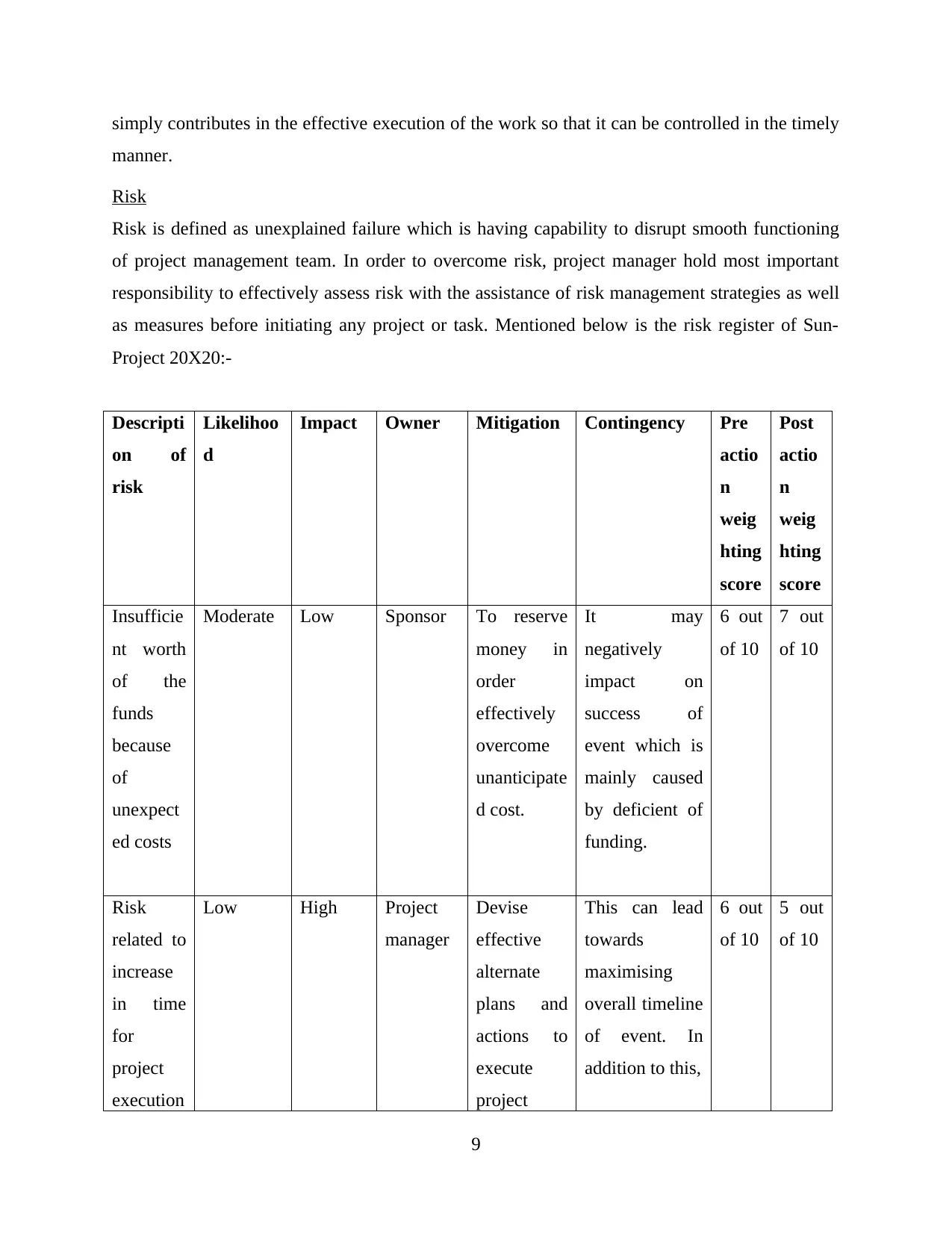
simply contributes in the effective execution of the work so that it can be controlled in the timely
manner.
Risk
Risk is defined as unexplained failure which is having capability to disrupt smooth functioning
of project management team. In order to overcome risk, project manager hold most important
responsibility to effectively assess risk with the assistance of risk management strategies as well
as measures before initiating any project or task. Mentioned below is the risk register of Sun-
Project 20X20:-
Descripti
on of
risk
Likelihoo
d
Impact Owner Mitigation Contingency Pre
actio
n
weig
hting
score
Post
actio
n
weig
hting
score
Insufficie
nt worth
of the
funds
because
of
unexpect
ed costs
Moderate Low Sponsor To reserve
money in
order
effectively
overcome
unanticipate
d cost.
It may
negatively
impact on
success of
event which is
mainly caused
by deficient of
funding.
6 out
of 10
7 out
of 10
Risk
related to
increase
in time
for
project
execution
Low High Project
manager
Devise
effective
alternate
plans and
actions to
execute
project
This can lead
towards
maximising
overall timeline
of event. In
addition to this,
6 out
of 10
5 out
of 10
9
manner.
Risk
Risk is defined as unexplained failure which is having capability to disrupt smooth functioning
of project management team. In order to overcome risk, project manager hold most important
responsibility to effectively assess risk with the assistance of risk management strategies as well
as measures before initiating any project or task. Mentioned below is the risk register of Sun-
Project 20X20:-
Descripti
on of
risk
Likelihoo
d
Impact Owner Mitigation Contingency Pre
actio
n
weig
hting
score
Post
actio
n
weig
hting
score
Insufficie
nt worth
of the
funds
because
of
unexpect
ed costs
Moderate Low Sponsor To reserve
money in
order
effectively
overcome
unanticipate
d cost.
It may
negatively
impact on
success of
event which is
mainly caused
by deficient of
funding.
6 out
of 10
7 out
of 10
Risk
related to
increase
in time
for
project
execution
Low High Project
manager
Devise
effective
alternate
plans and
actions to
execute
project
This can lead
towards
maximising
overall timeline
of event. In
addition to this,
6 out
of 10
5 out
of 10
9
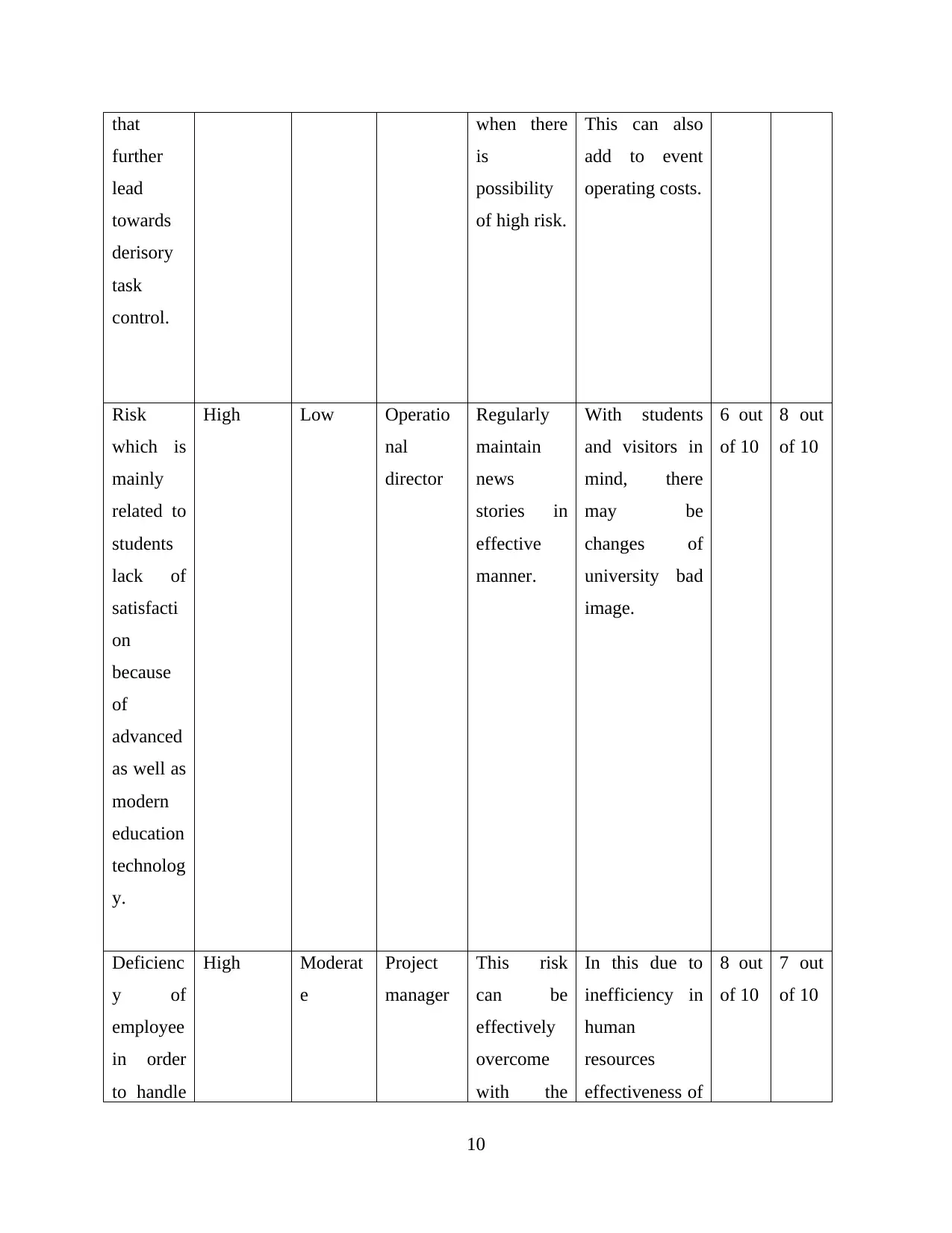
that
further
lead
towards
derisory
task
control.
when there
is
possibility
of high risk.
This can also
add to event
operating costs.
Risk
which is
mainly
related to
students
lack of
satisfacti
on
because
of
advanced
as well as
modern
education
technolog
y.
High Low Operatio
nal
director
Regularly
maintain
news
stories in
effective
manner.
With students
and visitors in
mind, there
may be
changes of
university bad
image.
6 out
of 10
8 out
of 10
Deficienc
y of
employee
in order
to handle
High Moderat
e
Project
manager
This risk
can be
effectively
overcome
with the
In this due to
inefficiency in
human
resources
effectiveness of
8 out
of 10
7 out
of 10
10
further
lead
towards
derisory
task
control.
when there
is
possibility
of high risk.
This can also
add to event
operating costs.
Risk
which is
mainly
related to
students
lack of
satisfacti
on
because
of
advanced
as well as
modern
education
technolog
y.
High Low Operatio
nal
director
Regularly
maintain
news
stories in
effective
manner.
With students
and visitors in
mind, there
may be
changes of
university bad
image.
6 out
of 10
8 out
of 10
Deficienc
y of
employee
in order
to handle
High Moderat
e
Project
manager
This risk
can be
effectively
overcome
with the
In this due to
inefficiency in
human
resources
effectiveness of
8 out
of 10
7 out
of 10
10
⊘ This is a preview!⊘
Do you want full access?
Subscribe today to unlock all pages.

Trusted by 1+ million students worldwide
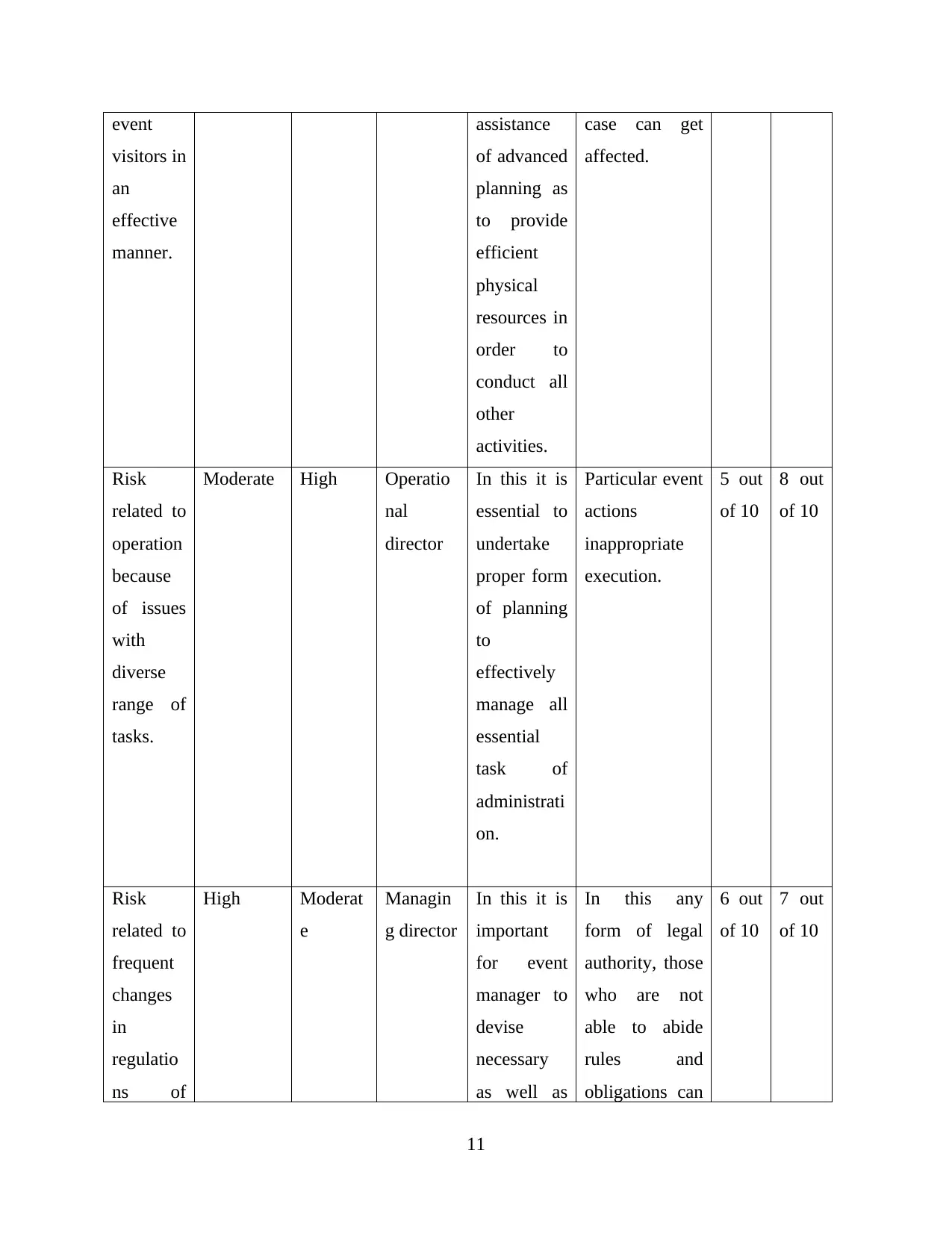
event
visitors in
an
effective
manner.
assistance
of advanced
planning as
to provide
efficient
physical
resources in
order to
conduct all
other
activities.
case can get
affected.
Risk
related to
operation
because
of issues
with
diverse
range of
tasks.
Moderate High Operatio
nal
director
In this it is
essential to
undertake
proper form
of planning
to
effectively
manage all
essential
task of
administrati
on.
Particular event
actions
inappropriate
execution.
5 out
of 10
8 out
of 10
Risk
related to
frequent
changes
in
regulatio
ns of
High Moderat
e
Managin
g director
In this it is
important
for event
manager to
devise
necessary
as well as
In this any
form of legal
authority, those
who are not
able to abide
rules and
obligations can
6 out
of 10
7 out
of 10
11
visitors in
an
effective
manner.
assistance
of advanced
planning as
to provide
efficient
physical
resources in
order to
conduct all
other
activities.
case can get
affected.
Risk
related to
operation
because
of issues
with
diverse
range of
tasks.
Moderate High Operatio
nal
director
In this it is
essential to
undertake
proper form
of planning
to
effectively
manage all
essential
task of
administrati
on.
Particular event
actions
inappropriate
execution.
5 out
of 10
8 out
of 10
Risk
related to
frequent
changes
in
regulatio
ns of
High Moderat
e
Managin
g director
In this it is
important
for event
manager to
devise
necessary
as well as
In this any
form of legal
authority, those
who are not
able to abide
rules and
obligations can
6 out
of 10
7 out
of 10
11
Paraphrase This Document
Need a fresh take? Get an instant paraphrase of this document with our AI Paraphraser
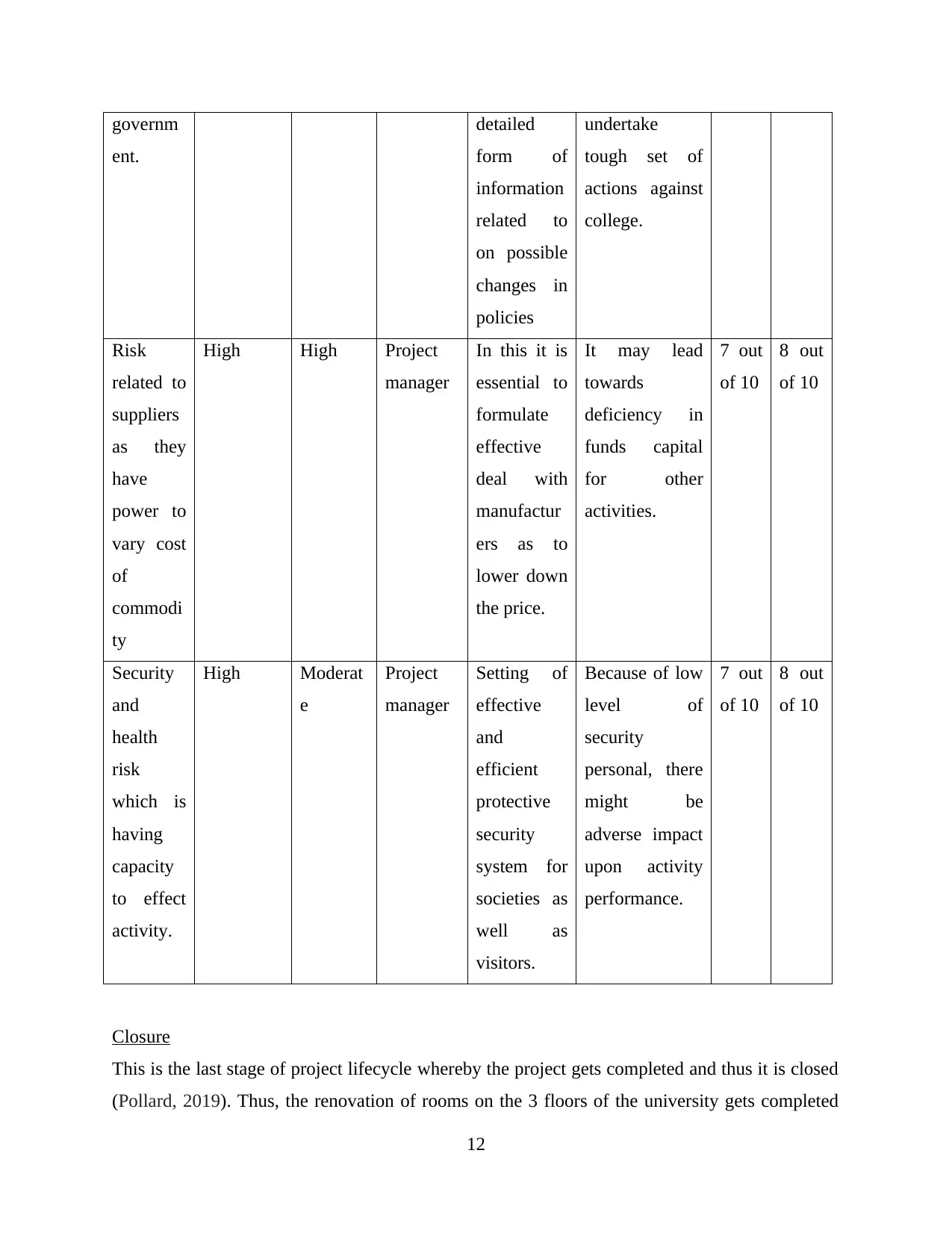
governm
ent.
detailed
form of
information
related to
on possible
changes in
policies
undertake
tough set of
actions against
college.
Risk
related to
suppliers
as they
have
power to
vary cost
of
commodi
ty
High High Project
manager
In this it is
essential to
formulate
effective
deal with
manufactur
ers as to
lower down
the price.
It may lead
towards
deficiency in
funds capital
for other
activities.
7 out
of 10
8 out
of 10
Security
and
health
risk
which is
having
capacity
to effect
activity.
High Moderat
e
Project
manager
Setting of
effective
and
efficient
protective
security
system for
societies as
well as
visitors.
Because of low
level of
security
personal, there
might be
adverse impact
upon activity
performance.
7 out
of 10
8 out
of 10
Closure
This is the last stage of project lifecycle whereby the project gets completed and thus it is closed
(Pollard, 2019). Thus, the renovation of rooms on the 3 floors of the university gets completed
12
ent.
detailed
form of
information
related to
on possible
changes in
policies
undertake
tough set of
actions against
college.
Risk
related to
suppliers
as they
have
power to
vary cost
of
commodi
ty
High High Project
manager
In this it is
essential to
formulate
effective
deal with
manufactur
ers as to
lower down
the price.
It may lead
towards
deficiency in
funds capital
for other
activities.
7 out
of 10
8 out
of 10
Security
and
health
risk
which is
having
capacity
to effect
activity.
High Moderat
e
Project
manager
Setting of
effective
and
efficient
protective
security
system for
societies as
well as
visitors.
Because of low
level of
security
personal, there
might be
adverse impact
upon activity
performance.
7 out
of 10
8 out
of 10
Closure
This is the last stage of project lifecycle whereby the project gets completed and thus it is closed
(Pollard, 2019). Thus, the renovation of rooms on the 3 floors of the university gets completed
12
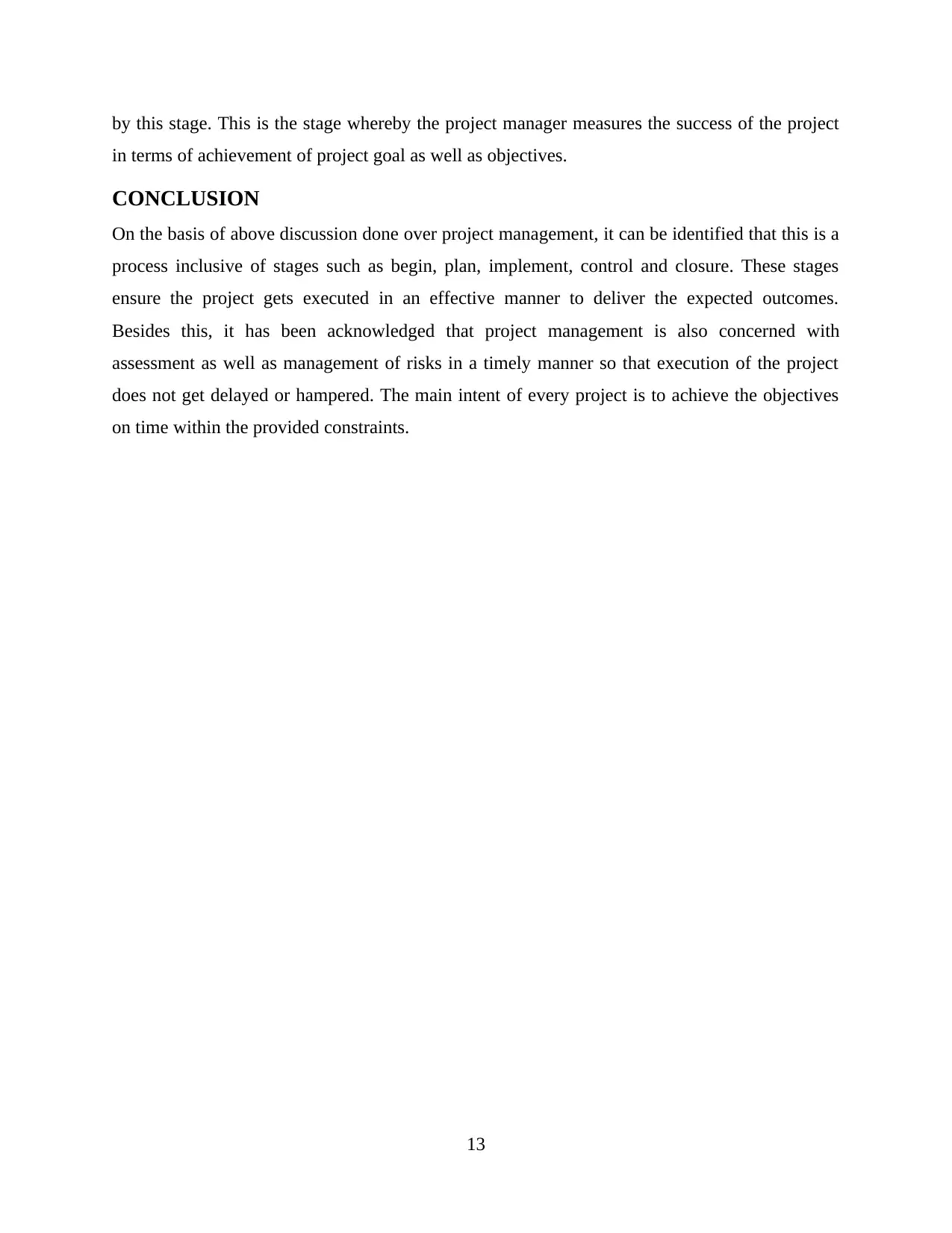
by this stage. This is the stage whereby the project manager measures the success of the project
in terms of achievement of project goal as well as objectives.
CONCLUSION
On the basis of above discussion done over project management, it can be identified that this is a
process inclusive of stages such as begin, plan, implement, control and closure. These stages
ensure the project gets executed in an effective manner to deliver the expected outcomes.
Besides this, it has been acknowledged that project management is also concerned with
assessment as well as management of risks in a timely manner so that execution of the project
does not get delayed or hampered. The main intent of every project is to achieve the objectives
on time within the provided constraints.
13
in terms of achievement of project goal as well as objectives.
CONCLUSION
On the basis of above discussion done over project management, it can be identified that this is a
process inclusive of stages such as begin, plan, implement, control and closure. These stages
ensure the project gets executed in an effective manner to deliver the expected outcomes.
Besides this, it has been acknowledged that project management is also concerned with
assessment as well as management of risks in a timely manner so that execution of the project
does not get delayed or hampered. The main intent of every project is to achieve the objectives
on time within the provided constraints.
13
⊘ This is a preview!⊘
Do you want full access?
Subscribe today to unlock all pages.

Trusted by 1+ million students worldwide
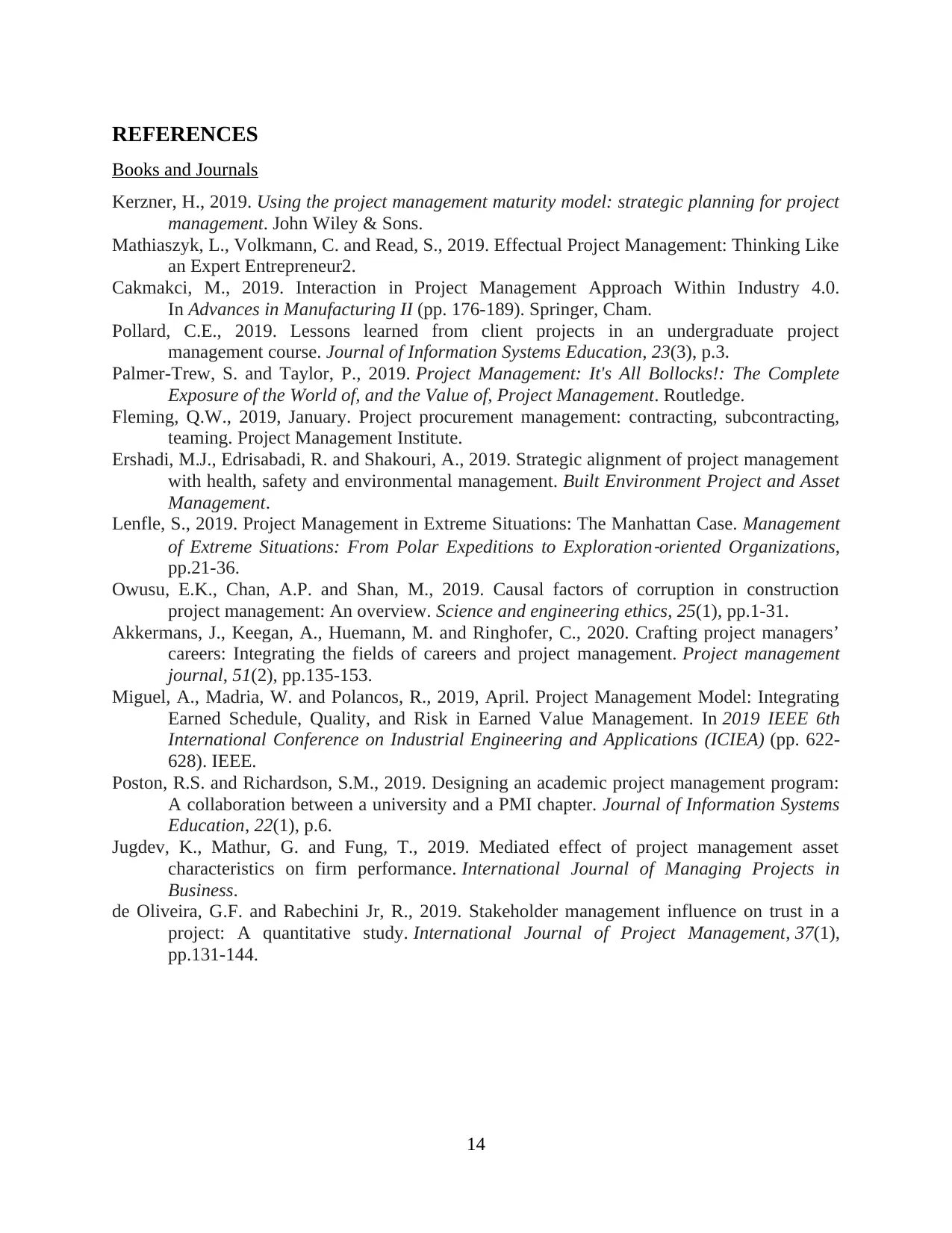
REFERENCES
Books and Journals
Kerzner, H., 2019. Using the project management maturity model: strategic planning for project
management. John Wiley & Sons.
Mathiaszyk, L., Volkmann, C. and Read, S., 2019. Effectual Project Management: Thinking Like
an Expert Entrepreneur2.
Cakmakci, M., 2019. Interaction in Project Management Approach Within Industry 4.0.
In Advances in Manufacturing II (pp. 176-189). Springer, Cham.
Pollard, C.E., 2019. Lessons learned from client projects in an undergraduate project
management course. Journal of Information Systems Education, 23(3), p.3.
Palmer-Trew, S. and Taylor, P., 2019. Project Management: It's All Bollocks!: The Complete
Exposure of the World of, and the Value of, Project Management. Routledge.
Fleming, Q.W., 2019, January. Project procurement management: contracting, subcontracting,
teaming. Project Management Institute.
Ershadi, M.J., Edrisabadi, R. and Shakouri, A., 2019. Strategic alignment of project management
with health, safety and environmental management. Built Environment Project and Asset
Management.
Lenfle, S., 2019. Project Management in Extreme Situations: The Manhattan Case. Management
of Extreme Situations: From Polar Expeditions to Exploration
‐oriented Organizations,
pp.21-36.
Owusu, E.K., Chan, A.P. and Shan, M., 2019. Causal factors of corruption in construction
project management: An overview. Science and engineering ethics, 25(1), pp.1-31.
Akkermans, J., Keegan, A., Huemann, M. and Ringhofer, C., 2020. Crafting project managers’
careers: Integrating the fields of careers and project management. Project management
journal, 51(2), pp.135-153.
Miguel, A., Madria, W. and Polancos, R., 2019, April. Project Management Model: Integrating
Earned Schedule, Quality, and Risk in Earned Value Management. In 2019 IEEE 6th
International Conference on Industrial Engineering and Applications (ICIEA) (pp. 622-
628). IEEE.
Poston, R.S. and Richardson, S.M., 2019. Designing an academic project management program:
A collaboration between a university and a PMI chapter. Journal of Information Systems
Education, 22(1), p.6.
Jugdev, K., Mathur, G. and Fung, T., 2019. Mediated effect of project management asset
characteristics on firm performance. International Journal of Managing Projects in
Business.
de Oliveira, G.F. and Rabechini Jr, R., 2019. Stakeholder management influence on trust in a
project: A quantitative study. International Journal of Project Management, 37(1),
pp.131-144.
14
Books and Journals
Kerzner, H., 2019. Using the project management maturity model: strategic planning for project
management. John Wiley & Sons.
Mathiaszyk, L., Volkmann, C. and Read, S., 2019. Effectual Project Management: Thinking Like
an Expert Entrepreneur2.
Cakmakci, M., 2019. Interaction in Project Management Approach Within Industry 4.0.
In Advances in Manufacturing II (pp. 176-189). Springer, Cham.
Pollard, C.E., 2019. Lessons learned from client projects in an undergraduate project
management course. Journal of Information Systems Education, 23(3), p.3.
Palmer-Trew, S. and Taylor, P., 2019. Project Management: It's All Bollocks!: The Complete
Exposure of the World of, and the Value of, Project Management. Routledge.
Fleming, Q.W., 2019, January. Project procurement management: contracting, subcontracting,
teaming. Project Management Institute.
Ershadi, M.J., Edrisabadi, R. and Shakouri, A., 2019. Strategic alignment of project management
with health, safety and environmental management. Built Environment Project and Asset
Management.
Lenfle, S., 2019. Project Management in Extreme Situations: The Manhattan Case. Management
of Extreme Situations: From Polar Expeditions to Exploration
‐oriented Organizations,
pp.21-36.
Owusu, E.K., Chan, A.P. and Shan, M., 2019. Causal factors of corruption in construction
project management: An overview. Science and engineering ethics, 25(1), pp.1-31.
Akkermans, J., Keegan, A., Huemann, M. and Ringhofer, C., 2020. Crafting project managers’
careers: Integrating the fields of careers and project management. Project management
journal, 51(2), pp.135-153.
Miguel, A., Madria, W. and Polancos, R., 2019, April. Project Management Model: Integrating
Earned Schedule, Quality, and Risk in Earned Value Management. In 2019 IEEE 6th
International Conference on Industrial Engineering and Applications (ICIEA) (pp. 622-
628). IEEE.
Poston, R.S. and Richardson, S.M., 2019. Designing an academic project management program:
A collaboration between a university and a PMI chapter. Journal of Information Systems
Education, 22(1), p.6.
Jugdev, K., Mathur, G. and Fung, T., 2019. Mediated effect of project management asset
characteristics on firm performance. International Journal of Managing Projects in
Business.
de Oliveira, G.F. and Rabechini Jr, R., 2019. Stakeholder management influence on trust in a
project: A quantitative study. International Journal of Project Management, 37(1),
pp.131-144.
14
1 out of 16
Related Documents
Your All-in-One AI-Powered Toolkit for Academic Success.
+13062052269
info@desklib.com
Available 24*7 on WhatsApp / Email
![[object Object]](/_next/static/media/star-bottom.7253800d.svg)
Unlock your academic potential
© 2024 | Zucol Services PVT LTD | All rights reserved.





